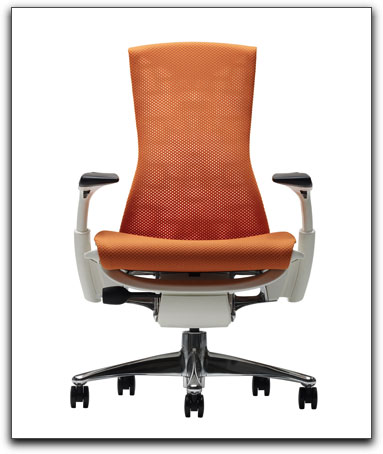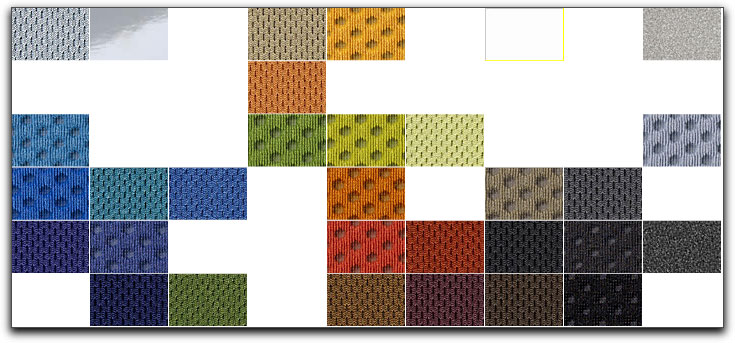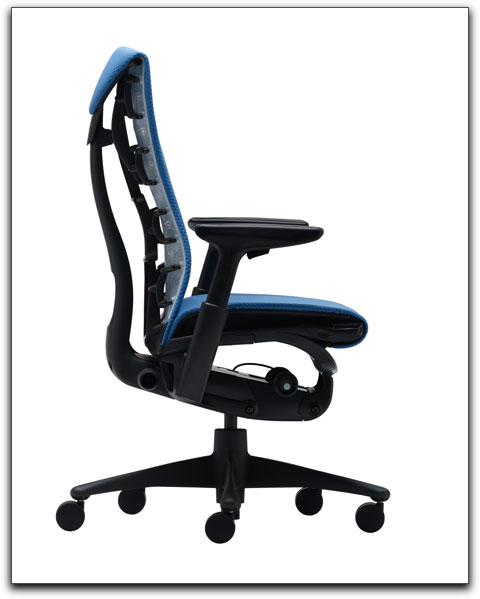
JUne 28, 2009
![]()
www.hermanmiller.com - $1,199.00
Review by Steve Douglas
After a great many years of jumping out of planes, carrying heavy scuba gear, competitive power lifting, and 30 years of teaching public school students which often required hours sitting behind a desk, who knew my back would eventually die on me? When a teacher in the public schools I just assumed that the lousy desk chairs they provided for us meant nothing more than a state of discomfort to endure for the day. Youth, being what it is, and I wish I could recapture that youth, denied me the foresight to see that those hours spent sitting on those hardwood seats correcting papers or counseling students was doing enough harm to my back that, though unforeseen, I would have to pay for it until much later in life. As a 25 year old, I'm not sure I even knew what 'lumbar support' even meant, and the youthful believe that I was going to be fit and healthy for all eternity only disintegrated over the last 5 years. Now, retired from teaching, I spend the majority of my time at the editing bay or on the computer writing articles. Despite having 3 vertebra fused a few years ago, I still find the ache in my lower back as disconcerting as I did before the operation, yet scuba diving, and continuing to edit and write is still my passion and I found it about time to do something that would help the situation. If it happened to me, a lifelong athlete until my mid forties, it can happen to anyone and probably will.
Obviously, a better working chair than my $68.00 special from Office Depot would be necessary. First I had to educate myself as to what really does make a good and healthful chair as opposed to those that are little more than pretenders to the throne.
Therefore, this review will be completed in two sections. First comes the research and theory behind the benefits of the Embody Chair. Once completed, this review will provide my subjective feelings and observations after having used it for a spell. After all, despite all the theories and designs in the world, the bottom line is always, 'Does it work?'
If there any of you who are bound to your computers for long periods of the day, and I am sure that there are, you will have experienced the stresses to tissue and muscles, restricted blood flow, and spinal discomfort that extended sitting can cause. For most, our chairs hinder the very movement that is critical to physical health and mental alertness. The results of a poorly designed and uncomfortable chair, at the very least, are discomfort, distraction and fatigue, and, later on, possibly a costly injury requiring chiropractic assistance, medical appointments, or even surgery. In the workplace, there is found little accommodation for creating a healthy relationship between the high performance expectations of the employee and creating a healthy work situation where the employee can remain focused behind the desk or at the editing bay and meet those high expectations. So, despite the poor economy, companies continue to accommodate the latest technology but often at the expense of the people who work with it preventing them from performing at their best.
The major task of a good chair for use at the computer should be to provide a positive postural equilibrium or proper support for the body's natural alignment through a wide range of body postures. If able to do so, the chair allows for the user to adjust their body positions yet maintain alignment support thus keeping the user healthier, more attentive and better able to perform at their best. If I am massaging my back attempting to sooth away the strain, I am not focusing on what I need to do in the editing bay. I am forced to take more frequent breaks, walk around, etc.
The Embody Chair, designed by the Herman Miller team, was developed after long research and design to provide not only a function platform from which to work, but one that would actually be healthy to the individual by restoring balance between the human/computer relationship by enhancing the intake of oxygen and cellular exchange of oxygen and carbon dioxide. It is designed to adapt to the individual's unique spinal curvature allowing you to move freely and naturally to improve blood flow thus eliminating both discomfort and distraction. The back of the chair is designed to be narrow in the back, allowing your arms to move back and forth naturally thus opening up the chest cavity which allows your lungs to take in more air and send more oxygen to the brain.
The pixilated seat moves with you and provides a 3-layered construction of materials whose technology conforms to your various micro movements while distributing your weight evenly. This then also removes stresses on your body at every contact point, reducing pressure and improving circulation. The Embody Chair has a unique tilt mechanism, which actually encourages the worker to recline while stabilizing the pelvis in the seat pocket no matter what your body position may be. This then supports your thoracic back while correctly aligning your eyes with the computer screen. The theory is that without continuing discomfort your mind is freed to focus on the task at hand.

The Embody Chair accommodates most everyone's size dimensions and preferences. The seat surface length can expand or contract to reduce pressure on the thighs without disrupting the user's position in the seat pocket and, additionally, is made for most any hip-breadth dimension.
Day One
The Herman Miller Embody Chair was delivered this morning. Mine came in a handsome black, but there is a very large assortment of colors to chose from.

Attached to the chair is a small folder which reviews the many controls to height, back curvature, arm distance and height, seat depth, tension limiter and recline. All controls work perfectly. The pamphlet instructs you as to what the optimum setting should be in regard to your arms, they should rest lightly on the arm pads to take weight off your shoulders, arm width, the chair's arms should allow your arms to fall naturally at your side, height, your feet should be able to rest flat on the floor or footrest, and the back fit adjustment which positions the back of the chair to your spine's natural curvature to keep your head and eyes aligned with your visual display. This last one is the only one I am not yet sure about as how many of us know what the natural curvature of our spines really are? I don't, so I am just adjusting it so that it feels comfortable. I am still sore from the last few week's intensive time spent on the computer in my Office Depot special so I can't realistically expect the soreness to disappear the moment my bottom sits in the Embody chair. However, I just realized that I am sitting as I should and not in that sidesaddle position I am likely to take when feeling sore.
Day 2
Been on the computer pretty much the whole day. Haven't unconsciously slipped into the sidesaddle position and, while still a bit sore, my back is starting to improve already. Because the Herman Miller Embody chair seems to automatically conform to your weight evenly, the support remains the same whether I am leaning forward or reclining. I've had to make no additional adjustments. The back of the chair actually looks and is shaped like a person's spine and since the back moves with me, forward or back, the support remains the same. As I work at the computer, it is very easy to forget that the chair is even there.

Day 3
Feeling a whole lot better. Coffee in hand, I caught myself leaning far back for a good wake-up yawn. There are so many things we do at the desk without thinking. It's these unconscious things we do that can get us into trouble; however, there was no sensation of the chair tipping over as I leaned back. The Herman Miller Embody chair is rock steady. I tipped over just last week with a client in the office; I was lucky not to break my head when the previous chair went over with me in it. It was embarrassing though.
No matter whether I am sitting forward or leaning back, the curvature of the Embody Chair remains fitted to my back providing constant substance and support. No matter what my forward or recline position may be, the thighs remain horizontal and the seat pocket prevents me from sliding down into and away from the back of the chair. Remember how mom always henpecked you to sit up and not slouch? Why did we slouch in the first place? Poor comfort and poor back support come to mind. The back support resulting from the Backfit adjustment allows for the flexible, segmented backrest to be fitted to my individual spinal curvature so as to achieve a postural balance appropriate for my body. Keep in mind, I am no expert on correct back support adjustments and probably if one of the Herman Miller design team were here, he might make changes to the way I adjusted the chair. Never the less, strictly from a laymen's perspective, the chair feels great and provides confidence as I am working.
When the Herman Miller Embody Chair was first delivered I was expecting a big cushiony seat and back, something I would sink into like the Titanic in the Pacific. I never really gave a thought to how the materials used in chairs affected our work and comfort. Most of the heavily cushioned chairs consist of a typical upholstery or leather over foam padding. This padding contains insulating properties that prevent conduction of heat away from the body, which is why, especially in humid times, the temperatures underneath the thighs and buttocks rise to greatly uncomfortable levels. The Embody chair developed a breathable and porous seat and backrest, which will allows for the conduction and dispersion of moisture away from the surface of the skin. What they are calling 'Pixelated Support' comes down to both a global and local spring layer to fit the individual's body shape. These negative spaces allow for air to flow through the layers. It's not yet hot and humid here is San Diego but I can't wait to see just what a difference the Embody Chair will make when the time comes.

 Steve Douglas is a certified Apple Pro for Final Cut Pro 6 and underwater videographer. A winner of the 1999 Pacific Coast Underwater Film Competition, 2003 IVIE competition, 2004 Los Angeles Underwater Photographic competition, and the prestigious 2005 International Beneath the Sea Film Competition, where he also won the Stan Waterman Award for Excellence in Underwater Videography and 'Diver of the Year', Steve was a safety diver on the feature film "The Deep Blue Sea", contributed footage to the Seaworld Park's Atlantis production, and productions for National Geographic and the History channels. Steve is also feature writer for Asian Diver Magazine and is one of the founding organizers of the San Diego UnderSea Film Exhibition. He is available for both private and group seminars for Final Cut Pro and leads underwater filming expeditions and African safaris with upcoming excursions to the Red Sea and Egypt for Nov.2009, Feel free to contact him if you are interested in joining Steve on any of these exciting trips.
Steve Douglas is a certified Apple Pro for Final Cut Pro 6 and underwater videographer. A winner of the 1999 Pacific Coast Underwater Film Competition, 2003 IVIE competition, 2004 Los Angeles Underwater Photographic competition, and the prestigious 2005 International Beneath the Sea Film Competition, where he also won the Stan Waterman Award for Excellence in Underwater Videography and 'Diver of the Year', Steve was a safety diver on the feature film "The Deep Blue Sea", contributed footage to the Seaworld Park's Atlantis production, and productions for National Geographic and the History channels. Steve is also feature writer for Asian Diver Magazine and is one of the founding organizers of the San Diego UnderSea Film Exhibition. He is available for both private and group seminars for Final Cut Pro and leads underwater filming expeditions and African safaris with upcoming excursions to the Red Sea and Egypt for Nov.2009, Feel free to contact him if you are interested in joining Steve on any of these exciting trips.